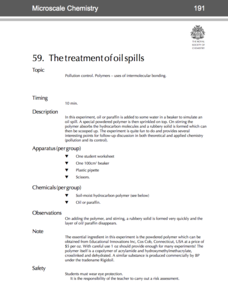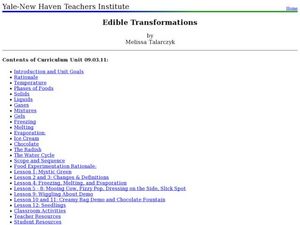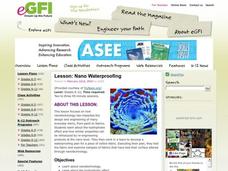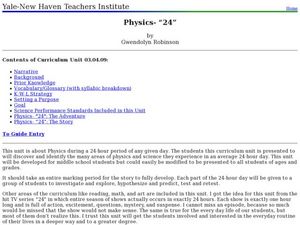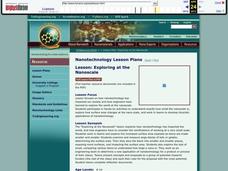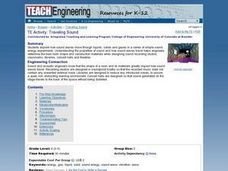Virginia Department of Education
Building a DNA Model
It has been decades since the discovery of DNA. Still, activities such building this DNA model allow blossoming scientists to better understand the components that form this overall structure. During this activity, they will also...
Teach Engineering
Where Are the Plastics Near Me? (Mapping the Data)
The last activity in a nine-part series has teams create a Google Earth map using the data they collected during a field trip. Using the map, groups analyze the results and make adjustments to the map to reflect their analysis. A short...
Annenberg Foundation
America's History in the Making: Using Digital Technologies
How can digital technology of today link us to the events of the past? Scholars use technology to uncover the vast number of historical resources available in lesson 12 of a 22-part America's History in the Making series. Using databases...
Perkins School for the Blind
The Printing Process
The printing process was a technological innovation that revolutionized the modern world. Your learners with visual impairments can experience this process by creating a print by using letterpress printing. They use cardboard, glue, and...
Royal Society of Chemistry
The Treatment of Oil Spills—Microscale Chemistry
When oil spills happen, how is the oil cleaned up? Pupils of polymer science discover an amazing substance that turns oil into a solid during a microscale experiment. Individuals observe oil or paraffin before and after addition of the...
Curated OER
Water Quality and Dissolved Oxygen
Students investigate the relationship between dissolved oxygen and organic materials and aquatic organisms. This is a 3-lesson series in which students explore dissolved oxygen and then design an experiment testing the effects of changes.
Curated OER
Strange New Planet
Students simulate different spacecraft missions using materials provided. In this space science lesson, students observe and record a planetary model's features from a distance. They relate this activity to scientists' space exploration...
Curated OER
Edible Transformations
Learners differentiate the different phases of matter. In this chemistry lesson, students conduct several hands-on exercises to discover how matter transforms when mixed together. They identify the different stages in the water cycle.
Curated OER
Launch Biotechnology into Your Classroom: Drug Delivery and Diffusion
Young scholars distinguish between diffusion and osmosis and describe ways that drugs can be administered. In this diffusion lesson students research career paths and create a presentation to give to the class.
Curated OER
Design Yer Genes
Seventh graders explore general structure of and natural changes that occur in DNA strands, and discuss concept of genetic engineering by creating small portion of strawberry chromosome with three genes, modeling naturally occurring...
Curated OER
More About Static Electricity
Students examine the concept that static electricity is a phenomenon that involves positive and negative charges. They explore the Static Electricity section of the Science, Technology and Engineering website to learn more about the...
TryEngineering
All About Electric Motors
Learners study the basic principles of electric motors and explore everyday uses. They build a working model of an electric motor for classroom use, using an inexpensive kit. Then, they work as an "engineering" team to determine the...
Curated OER
Nano Waterproofing
Learners experiment to determine a way to waterproof a piece of cotton fabric. In this scientific inquiry lesson, students use reference worksheets to explore waterproofing and the use of nanotechnology in engineering everyday...
Curated OER
Energetic Energy: A Child?s Guide to Responsible Energy Use
Students explore how energy transforms into heat. In this energy lesson students create models and find a need for fuel to make a Stirling engine.
Curated OER
Physics "24"
Students construct a model house or school. In this physics lesson, students research about who wind up clocks work and write an essay about it. They determine the center of gravity of different objects.
Curated OER
Exploring at the Nanoscale
Students examine how surface area increases as blocks are cut into pieces. In this technology lesson, students propose a new application of nanotechnology. They create charts or presentations and present them in class.
Curated OER
Exploring Magnetism
Eighth graders study magnetism. For this solar wind lesson students complete several activities on space and weather.
Curated OER
Cross-Cultural Exploration
Young scholars in an ESL classroom identify and locate the states on a United States map. Using the internet, they research to compare the holidays in their home country and the United States. They share their findings in an email to...
Curated OER
Bon Voyage: Travel and Exploration
Pupils use the internet and other media to locate and collect information about travel. They interpret the information they collect and convert American currency to foreign currency. Students create scale drawings of travel cards.
Curated OER
Exploring the Celestial Neighborhood
Ninth graders study the origin and organization of the solar system. They investigate the Earth's place in the system and how planetary motions explain natural phenomena observable from Earth.
Curated OER
Exploring Gear Trains
Students work together to build a simple gear train. They record their observations as it gains speed and how the gears rotate. They develop rules about gears based on these observations.
Curated OER
Exploring the Elements of Stewardship
Students examine stewardship activities and issues relating to the Department of Energy's activities on the Oak Ridge Reservation. They identify seven elements of an effective stewardship program, and conduct Internet research.
Curated OER
Traveling Sound
Young scholars explore how sound waves move through liquids, solids and gases in a series of simple sound energy experiments. They describe how sound needs molecules to move and that changing the medium that it travels through changes...
Curated OER
Naturally Speaking
Students identify the Earth's natural resources and classify them as renewable or non-renewable. They simulate the distribution of resources and discuss the fairness and effectiveness of the distribution. They identify ways that they use...




